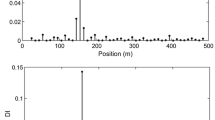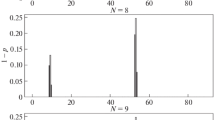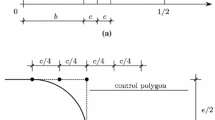Abstract
A method for identification of multiple transverse cracks and other localized defects in a rod by means of two spectra of longitudinal vibrations that correspond to free–free and fixed–free end conditions is presented. A numerical algorithm is developed that implements the method. The algorithm was tested on experimental data obtained on a cylindrical sample of aluminum alloy D16 with the created localized damages. The experiments were carried out on a rod with free ends. The created damages were ring grooves symmetrically located relative to the middle of the rod. With the help of such experiments, natural frequencies were obtained that correspond to two types of boundary conditions for a half-length rod. The experimental data were processed using the developed algorithm. The results showed that the model on which the developed algorithm is based describes well the longitudinal vibrations of the rod with localized damages in a fairly wide frequency range, and the algorithm enables to reconstruct multiple damages accurately enough.











Similar content being viewed by others
References
Morassi, A.: A uniqueness result on crack location in vibrating rods. Inverse Probl. Eng. 4, 231–254 (1997)
Morassi, A.: Identification of a crack in a rod based on changes in a pair of natural frequencies. J. Sound Vib. 242, 577–596 (2001)
Ruotolo, R., Surace, C.: Natural frequencies of a bar with multiple cracks. J. Sound Vib. 272, 301–316 (2004)
Dilena, M., Morassi, A.: The use of antiresonances for crack detection in beams. J. Sound Vib. 276, 195–214 (2004)
Rubio, L., Fernandez-Saez, J., Morassi, A.: Identification of two cracks in a rod by minimal resonant and antiresonant frequency data. Mech. Syst. Signal Process. 60–61, 1–13 (2015)
Rubio, L., Fernandez-Saez, J., Morassi, A.: Identification of two cracks with different severity in beams and rods from minimal frequency data. J. Vib. Control 22, 3102–3117 (2016)
Shifrin, E.I.: Identification of a finite number of small cracks in a rod using natural frequencies. Mech. Syst. Signal Process. 70–71, 613–624 (2016)
Rubio, L., Fernandez-Saez, J., Morassi, A.: The full nonlinear crack detection problem in uniform vibrating rods. J. Sound Vib. 339, 99–111 (2015)
Shifrin, E.I.: Inverse spectral problem for a rod with multiple cracks. Mech. Syst. Signal Process. 56–57, 181–196 (2015)
Shifrin, E.I.: Inverse spectral problem for a non-uniform rod with multiple cracks. Mech. Syst. Signal Process. 96, 348–365 (2017)
Lebedev, I.M., Shifrin, E.I.: Solution of the inverse spectral problem for a rod weakened by transverse cracks by the Levenberg–Marquardt optimization algorithm. Mech. Solids 54, 857–872 (2019)
Lourakis, M.I.A.: A brief description of the Levenberg-Marquardt algorithm implemented by levmar. Found. Res. Technol. 4, 1–6 (2005)
Fox, R.L., Kapoor, M.P.: Rates of change eigenvalues and eigenvectors. AIAA J. 6, 2426–2429 (1968)
Kanzow, C., Yamashita, N., Fukushima, M.: Levenberg–Marquardt methods with strong local convergence properties for solving nonlinear equations with convex constraints. J. Comput. Appl. Math. 172, 375–397 (2004)
Zetlab functions [Electronic resource]. https://zetlab.com/product-category/programmnoe-obespechenie/funktsii-zetlab.
Gasior, M., Gonzalez, J.L.: Improving FFT frequency measurement resolution by parabolic and Gaussian spectrum interpolation. Proc. AIP Conf. 732, 276–285 (2004)
Dilena, M., Morassi, A.: Structural health monitoring of rods based on natural frequency and antiresonant frequency measurements. Struct. Health Monitor. 8, 149–173 (2009)
Acknowledgements
The support of Ministry of Science and Higher Education (Project Reg. No AAAA-A20-120011690132-4) and RFBR (Grant 19-01-00100) is gratefully acknowledged.
Author information
Authors and Affiliations
Corresponding author
Additional information
Publisher's Note
Springer Nature remains neutral with regard to jurisdictional claims in published maps and institutional affiliations.
Rights and permissions
About this article
Cite this article
Shifrin, E.I., Popov, A.L., Lebedev, I.M. et al. Numerical and experimental verification of a method of identification of localized damages in a rod by natural frequencies of longitudinal vibration. Acta Mech 232, 1797–1808 (2021). https://doi.org/10.1007/s00707-020-02919-w
Received:
Revised:
Accepted:
Published:
Issue Date:
DOI: https://doi.org/10.1007/s00707-020-02919-w




